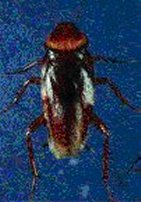
AMERICAN COCKROACHES
American cockroaches are also known as waterbugs, flying water bugs, and , in some areas of the south, palmetto bugs. It is the largest of the common species. In the northern states, this insect is commonly associated with steam heat tunnels. Where there are no steam heat tunnels, then they are generally found only in large institutional buildings. They can also be found under manhole covers and under large metal covers for sump pumps. In the south, this roach is common in alleyways, yards, hollow trees, and palm trees. Sometimes they are found under roof shingles or flashing, or even in the attic. In large city buildings, American cockroaches are found in dark, damp and warm places and are found more or less in open spaces as opposed to hidden cracks and crevices. They are often found in or near steam pipes, severs, grease traps, floor drains, pipe chases, damp basements, and other similar places. They are also found in sanitary and storm drains / sewers. |
HABITS
In the South, the American cockroach can often be found outside in the landscape along with other large species. They will move inside during evening foraging or when the weather conditions are less desirable. Inside, they tend to be found in the areas as described above. American cockroaches feed on a variety of foods, but prefer decaying organic matter. They will also feed on book bindings, manuscripts, clothing and glossy paper, as well as syrup and other sweets. |
AMERICAN COCKROACH MANAGEMENT
The key to American cockroach management has to do with exclusion techniques and pesticide application. |
| The first area of concern has to do with EXCLUSION. American cockroaches tend to be carried into the buildings in colder climates along with shipping cartons and furniture. Inspection of these items should help to prevent any infestation. In the South, where American cockroaches are more abundant, they will tend to enter the building through any opening they can find. Caulking and sealing various openings should reduce the risk of infestation. In weep holes in exterior brick facade, insert small square of window screening into the holes with a putty knife or screwdriver. |
| Finally, the use of PESTICIDES for the treatment of cockroaches may be needed. The first step in determining if and how much pesticide treatment is needed is to determine the level of infestation. An inspection, using a flashlight, should be performed. For small infestations and for prevention, the liberal use of cockroach bait, placed in the above types of areas, along with exclusion procedures, should solve or prevent any American cockroach problems. Also, the spraying of the exterior of the building near the foundation, especially in the South, with an appropriately labeled liquid pesticide, should help to prevent the American cockroach from entering the building. When infestations are found in the landscaping, spraying these areas with the appropriate pesticide should help reduce the pressure of these insect from coming in. Be careful, however, not to spray firewood. For mild infestations, aerosol treatments in cracks and crevices, along with immediate cleaning and the use of baits, should suffice. However, heavy infestations, and to some degree mild infestations, should be handled by a pest management professional. |
